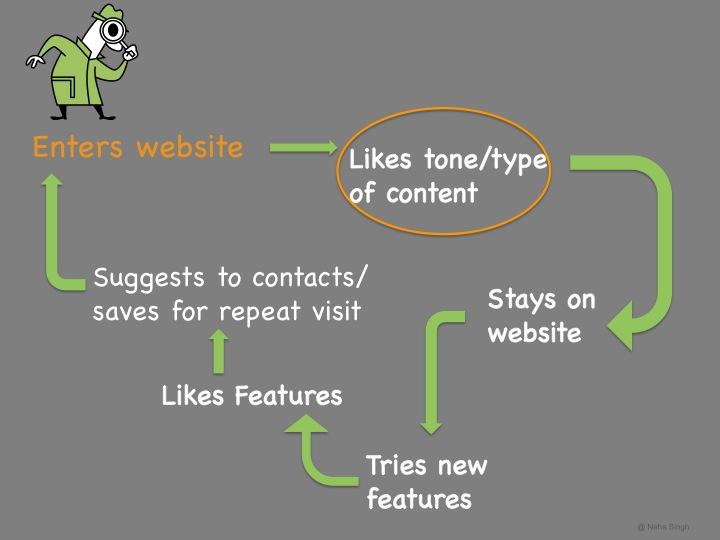Any good online user experience is not just about well-planned design—it is also about the actual “meat of the matter”—content. Unless web content is usable, targeted, and relevant, websites will not communicate the correct messages to their purported user bases.
In general, content isn’t associated with user experience discussions. It’s “copy” and is considered a simple, last minute thing. However, in reality, content is difficult and time consuming and has a life cycle of its own. Unless this fact is recognized in every usability project, websites may continue to face failures.
Let’s consider a hypothetical conversation between a client and content strategist:

Here is a successful website. It’s doing well but there is a problem. The feedback form is lately filled with negatives.

I think I know where this is going.

The negatives mostly relate to how the photos are wrong or the data is irrelevant or the details are outdated or the copy is boring. Looks like there is something you can do here.

You mean, re-strategize the content in the website, right?

Oh no—it’s very simple. Just make a few tweaks here and there—make copy look better, add some zany language.

Yeah, so we need to look into all content areas and ensure they reflect brand voice, have appealing formatting, are complete and updated, are easy to find…

Err something like that. Shouldn’t be complicated.

Yeah—not complicated at all (sigh).
In reality, content can be very complicated. The following are cures for common issues that may arise when developing content, elucidating why content needs far more attention than it normally gets.

Content development and strategy is a constant uphill battle.
Patient listing
As a basic requirement, there would be the process of creating a content inventory to get a clear picture of what is already there. This alone could be long-drawn, depending on the website’s scope and size. It could be a straightforward listing out of top-level navigation, or it could require covering every single piece of content out there.
In any case, someone would have to be focused on getting all content areas listed out neatly and this takes time —and lots of patience!
Analytical reading
Once inventory is done, analysis begins (for a great rundown of content analysis, visit Colleen Jones’ Content Analysis: A Practical Approach).
A basic measurement here could be the ROT (Redundant, Outdated, Trivial) analysis. With each content area listed out in content inventory, a ROT analysis helps eliminate/hide unnecessary content immediately.
The next level of measurement might include a quantitative analysis of content quality content. The content modules identified in the inventory would have to be measured against a basic content quality checklist , again clearly explained by Colleen Jones—findability, accuracy, clarity, completeness, consistency, and brand voice.
Now, if findability were an issue, the next step (in a content plan) would involve working with SEO specialists to fix it. If the brand voice isn’t coming out clearly in content, the editorial guidelines on content would need to be reworked.
Another way of looking at the content quality is at a modular level. For instance, if the quantitative analysis would indicate that a particular content module was not accurate, complete, or with a brand voice, a redo of that module would have to be done.
For this, someone would have to read. All the content, actively and analytically.
Foolproof planning
Now, start with the content plan. For each issue found during analysis, create and implement a solution that will fix it soundly.
Let’s say findability is a major pain. Solution—check with an SEO specialist or becomes one yourself. List out all the relevant keywords and decide where they should be placed for maximum impact.
Another issue is poor presentation that makes reading difficult. To fix this, decide on reformatting of content. Create templates that show exactly what formatting would work for the specific content module.
What if there is trouble brewing in the accuracy and relevance departments? Well, then create guidelines to ensure all data is complete, accurate, and up-to-date.
Yet another problem: no consistent voice can be found across various sections in the module. If this is the case, it may be best to refer to the brand voice manual or create one with the help of brand/marketing manager.
Many more problems and their accompanying solutions could have been listed here to highlight what ails content, but I think you get the idea. Content would now need to be rewritten with all the above points in mind.
Stakeholder convincing
Armed with the plan, discuss the possibility of new content with stakeholders. Explain the need of rewriting content and convince them of the need of guidelines/templates/manuals for success.
Of course, new content means new budget allocation. It also means renegotiating with content providers and increasing time slot for content—each of which requires increased man-hours.
This step is, regardless to say, no easier than the others. Besides, sudden change in attitude towards content confuses the previously complacent team. The result is you now end up giving more presentations, attending more meetings, and sending more emails—basically checking your inner wallflower at the door to champion the cause.
With any luck, everyone will agree with you after a while, and the rewriting can begin.
Vigilant monitoring
Now that the wheel is set in motion, active monitoring is vital. Review all new content and check for compliance. If things are going as planned, great. Else, renegotiate, re-strategize, and recreate.
Uncomplicated conclusion
There is nothing easy about content development and management. But it is almost always difficult if you are writing for an online audience that is barraged with tons of information, often simultaneously. The competition for a user’s coveted attention is stiff, and the possibility that similar content appears elsewhere is high. The chances of the user returning to your particular content are very low.
Hence you cannot make a few alterations in content and hope to appease and persuade your audience. You need a plan. You need analysis and reviews. You need someone to look at the big picture and say, “Let’s make all our content engaging; let it have a youthful voice.”
These things can’t be done instantly. It all requires a dedicated staff to deliberate and strategize.
It’s a grave mistake to consider content anything but complicated. If design is considered prime enough for usability testing, research and reviews, so should content. Otherwise, someone will continue with “minor copy tweaks” while users will continue to choose other websites.

So this copy tweaking is going to take some time, is it?

Yes. A lot. (grin).